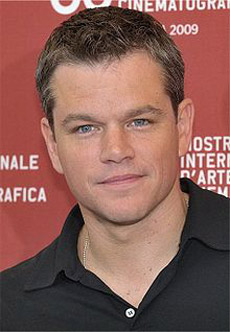Matt Damon's Anti-Fracking Movie, 'The Promised Land,' Is Ahead of the Curve
 The word’s just come down that Matt Damon’s new movie The Promised Land, which apparently centers around a salesman and a small town, apparently is also about the environmental impact of hydraulic fracturing, and it’s already become a football in the war over the natural gas extraction process. A pro-fracking group is already trying to raise money for a movie of their own off the existence of The Promised Land. And while Damon is well-known as a committed environmentalist, the movie seems likely to be taken as a referendum for how John Krasinski and Dave Eggers, who wrote the script, and Gus Van Sant, who will direct, feel about fracking. All of which is a distraction from the real issue—a lot of our most critical environmental issues and most invasive energy-extraction processes would make for stellar movies and action sequences, and we ought to have more of them.
The word’s just come down that Matt Damon’s new movie The Promised Land, which apparently centers around a salesman and a small town, apparently is also about the environmental impact of hydraulic fracturing, and it’s already become a football in the war over the natural gas extraction process. A pro-fracking group is already trying to raise money for a movie of their own off the existence of The Promised Land. And while Damon is well-known as a committed environmentalist, the movie seems likely to be taken as a referendum for how John Krasinski and Dave Eggers, who wrote the script, and Gus Van Sant, who will direct, feel about fracking. All of which is a distraction from the real issue—a lot of our most critical environmental issues and most invasive energy-extraction processes would make for stellar movies and action sequences, and we ought to have more of them.Documentaries have been much quicker than features to document environmental problems and environmentally-dangerous practices. Both Tuvalu: That Sinking Feeling and The Island President, about Mohamed Nasheed, the now-ousted president of the Maldives who’s become an outspoken advocate about the dangers of global warming, have chronicled the island nations that are canaries in the coal mine for rising sea levels. Gasland’s helped up the profile of hydraulic fracturing, and Robert Kennedy Jr.’s documentary The Last Mountain takes a look at the impact of mountain-top removal mining.
But all of these subjects would make for excellent, tense fictionalized films as well. Anna North’s America Pacifica and Kim Stanley Robinson’s Mars trilogy are only two works suitable for adaptation that chronicle the instability of relocating costal and island populations as the amount of available habitable land shrinks, and you could tell those stories from the perspective of people being moved or the people planning airlifts and handling the resulting instability. Fracking involves the kind of big machinery, complex machinery and poison gunk that action movie directors go to great lengths to invent (or license from toy companies). And mountaintop removal mining means blowing up large chunks of geography. Why invent an erupting volcano or an unlikely meteor’s arrival when we’re already doing things that are so destructive and lend themselves to dramatic movie visuals in the first place?
You can return to the main Market News page, or press the Back button on your browser.

